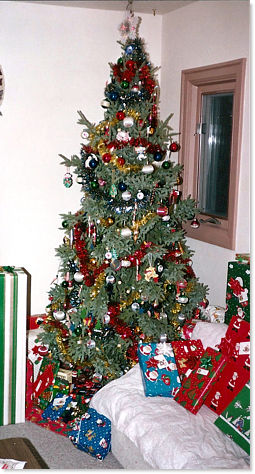
The Origins of the Christmas Tree
| By Johnny Caryopsis |
 Pagan or Christian, I still
Pagan or Christian, I stilllike my Christmas tree!
Trees have long been considered to be symbols of life. Their size, which dwarfs us humans; their longevity; their provision of food and materials; and their obvious role as habitat for other animals have long been recognized by people. So it shouldn't be surprising that trees have been revered and even worshiped throughout the ages. The roots of the modern Christian Christmas tree tradition stretch back to pagan times in northern Europe. (Remember, much of our modern "Western" culture stems from the customs of a few northern and western regions of Europe. People from these regions just happened to be the first to truly master sea travel and thus spread their cultures far afield and cast their influence far wider than was previously possible.)
The early pre-Christian religions in the high latitudes of Europe placed great significance in the comings and goings of the sun, and its obvious effects, producing the distinct seasons of spring, summer, autumn and winter. The winter solstice, which, although it occurs in the heart of winter, signifies the beginning of the return of the sun, was a most revered event and the subject of much festivities. It also appears to have been the root of our modern day Western Christmas.
The Christmas tree origin is thought to be related to one very specific event, in the early part of the 8th century A.D. in northern Germany. An early Christian missionary, now known as St. Boniface, felled a great oak tree that was a center of worship for the then Druid peoples. In felling the tree Saint Boniface hoped to symbolize the end of the old beliefs. However, the legend maintains that a small fir sapling was somehow left standing (or later appeared, depending on the version of the legend), and the missionary offered up this new tree as a symbol for emergence of the new Christian beliefs. (Hey, if you're dealing with tree worshipers, its best not to push them too far in one step!) So, hence forth, fir trees came to be associated with the early Christian rituals in this part of the world. Instead of decorating oak trees for the winter solstice, as had been the custom in pagan times, the new found Christians decorated fir trees for "Christmas" (the mass celebrating Christ's birth). It is no coincidence that our Western Christmas falls just after the solstice. The early missionaries of Christendom were wise enough to know that it was one thing to change the nature of the gods people believed in (and which type of tree they might revere), but it was quite another thing to tamper with the timing of a great and traditional festival. So the Christian stories and mythology were adapted to the existing culture of these people ("the return of the sun" shifted to the "coming of the son"), and in much the same manner Christianity and other religions have spread and continue to spread to this day.
The more modern use of Christmas trees as indoor decorations is thought to have been well established by the 16th century in Germany. From Germany the custom spread through much of western Europe. Queen Victoria's German consort, Prince Albert, is credited with popularizing the tradition in England in the mid-1800's. Early in the 17th century, German immigrants to what is now Pennsylvania in the United States are thought to have been the first to trans-locate the tradition in the new world, but with the great onslaught of European immigration the tradition "arrived" many times since.
At least that's the state of things that I was able to track down. There's likely other versions out there, too. Take your pick!
Carry on for the Biology of the Black Spruce tree!![]()
| You can help NatureNorth produce more great articles with a secure donation through PayPal. Our Google Adsense ads pay our server costs, but that's about it. To learn more follow this link: Support NatureNorth. Thank-you! | |
Return to: Winter Issue | NatureNorth Front page
